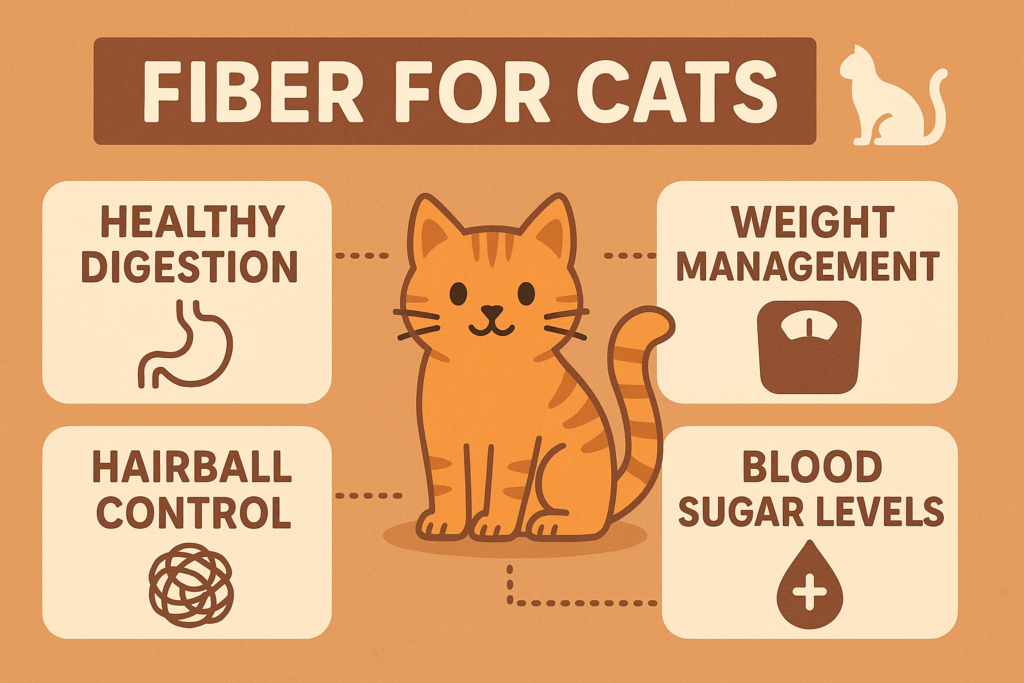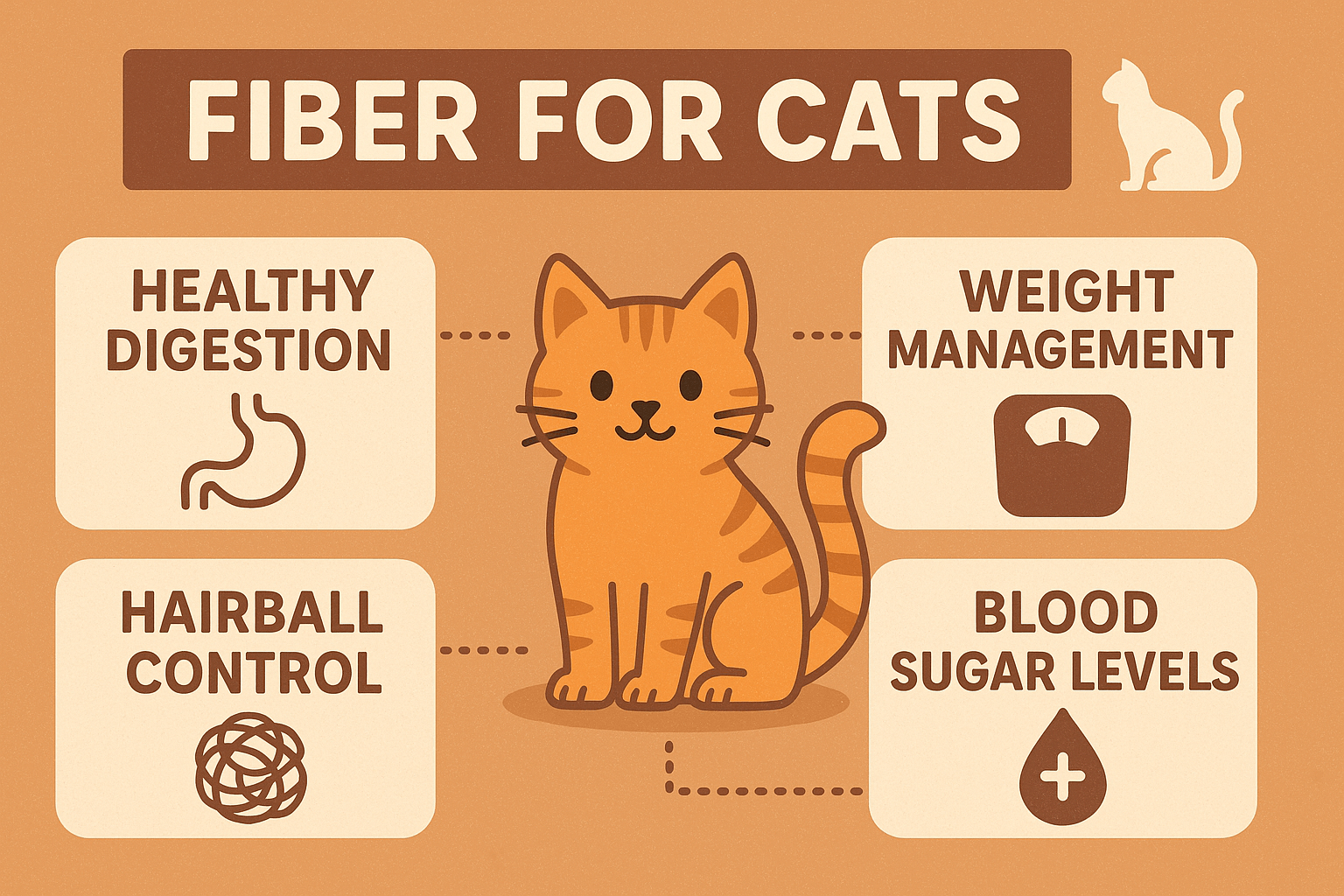Fiber for Cats: Why It Matters and How to Incorporate It
When it comes to feline nutrition, protein often steals the spotlight. However, fiber plays a crucial role in maintaining your cat’s digestive health and overall well-being. While cats are obligate carnivores, meaning their diet is primarily meat-based, a small amount of fiber can work wonders for their digestive system. From preventing hairballs to supporting weight management, fiber is an essential component that shouldn’t be overlooked. In this blog post, we’ll explore the importance of fiber for cats, how much they need, and practical ways to incorporate it into their diet. Whether you’re a seasoned cat owner or new to pet care, understanding the benefits of fiber will help you keep your furry friend happy and healthy.
Expert Opinion: The Importance of Fiber in a Cat’s Diet
“The amount of fiber in a cat’s diet can influence how often they go to the bathroom, the consistency of their stool, and how well their colon functions. When a cat doesn’t get enough fiber in their diet, their intestinal health can be negatively impacted. That’s why it’s important to ensure your cat’s diet includes the right amount and type of fiber.”
Why Fiber Is Important for Your Cat’s Health
Fiber might not be the first thing you think of when planning your cat’s meals, but its benefits are undeniable. Here’s why fiber deserves a place in your cat’s diet.
Promotes Healthy Digestion:
Fiber helps regulate bowel movements, ensuring your cat’s digestive system functions smoothly and reducing the risk of constipation.Prevents Hairball Formation:
Cats groom themselves frequently, ingesting loose fur. Fiber aids in moving hair through the digestive tract, minimizing hairball issues.Supports Weight Management:
High-fiber foods can help overweight cats feel fuller for longer, making it easier to manage their weight effectively.Improves Colon Health:
Adequate fiber intake supports a healthy colon by promoting regularity and reducing the risk of gastrointestinal disorders.Balances Blood Sugar Levels:
Soluble fiber slows down digestion, which can help stabilize blood sugar levels and benefit cats with diabetes.
By incorporating fiber into your cat’s diet, you can address a variety of health concerns while promoting long-term wellness.

How Much Fiber Does Your Cat Need?
While fiber is beneficial, cats require it in moderation. Too much fiber can lead to digestive upset, so it’s important to strike the right balance. Here’s what you need to know about determining the appropriate amount of fiber for your cat.
General Guidelines:
Most veterinarians recommend that fiber make up no more than 10% of a cat’s total diet to avoid digestive issues.Individual Needs Vary:
Factors like age, activity level, and existing health conditions can influence how much fiber your cat requires. Always consult your vet for personalized advice.Signs of Too Much Fiber:
Excessive fiber can cause diarrhea, gas, or bloating. Monitor your cat’s stool consistency to ensure the fiber level is appropriate.Commercial Cat Food Labels:
Check the ingredient list on your cat’s food for sources of fiber, such as pumpkin, beet pulp, or cellulose. Aim for moderate amounts.Supplementing Carefully:
If adding fiber supplements, start with small amounts and gradually increase to avoid overwhelming your cat’s system.
Understanding your cat’s unique needs ensures they receive the right amount of fiber to support their health without overdoing it.
Check this guide 👉Cat Raw Food Diet: Best 7 Health Tips!
Check this guide 👉Overweight Cat Causes: Best 7 Expert Tips!
Check this guide 👉How Much Does Cat Food Cost Per Month? Best 7 Tips!
Benefits of Fiber for Cats | Best Sources of Fiber |
|---|---|
Prevents hairballs | Pumpkin (plain, canned) |
Supports healthy digestion | Psyllium husk (fiber supplement) |
Aids in weight management | Green beans (steamed or plain) |
Reduces risk of constipation | Beet pulp (found in some cat foods) |
Promotes colon health | Sweet potatoes (cooked, unseasoned) |
How to Add Fiber to Your Cat’s Diet Safely
Incorporating fiber into your cat’s diet doesn’t have to be complicated. With a few simple adjustments, you can provide the right amount of fiber to support their health.
Introduce Gradually:
Sudden changes to your cat’s diet can upset their stomach. Start by adding small amounts of fiber-rich foods and monitor their reaction.Use Plain Ingredients:
Avoid foods with added sugars, spices, or seasonings. Stick to plain, unprocessed options like cooked pumpkin or green beans.Mix with Regular Food:
Blend fiber-rich foods into your cat’s regular wet or dry food to make it more appealing and easier to consume.Monitor Stool Consistency:
Keep an eye on your cat’s litter box habits. If stools become too loose or too firm, adjust the fiber content accordingly.Consult Your Veterinarian:
Before making significant dietary changes, seek professional advice to ensure your cat’s specific needs are met.
By taking these steps, you can safely enhance your cat’s diet with fiber while avoiding potential pitfalls.
Signs Your Cat Needs More Fiber
If your cat is experiencing certain symptoms, it might be a sign that their diet lacks sufficient fiber. Here’s what to look out for and how fiber can help.
Frequent Hairballs:
If your cat is coughing up hairballs regularly, increasing fiber can help move hair through their digestive system more efficiently.Constipation:
Hard, dry stools or difficulty passing feces may indicate a lack of dietary fiber. Adding fiber can soften stools and improve regularity.Weight Gain:
Overweight cats may benefit from high-fiber foods that promote satiety and reduce overeating tendencies.Loose Stools:
While too much fiber can cause diarrhea, a balanced amount can actually help firm up loose stools in some cases.Excessive Grooming:
Cats that groom excessively may ingest more fur, requiring extra fiber to prevent blockages or discomfort.
Recognizing these signs allows you to address potential issues proactively and improve your cat’s quality of life.
Common Mistakes to Avoid When Adding Fiber
Adding fiber to your cat’s diet is beneficial, but mistakes can lead to unintended consequences. Avoid these common errors to ensure your cat’s fiber intake remains safe and effective.
Overloading Their Diet:
Adding too much fiber at once can overwhelm your cat’s digestive system. Introduce it slowly to allow their body to adjust.Using Processed Human Foods:
Many processed human foods contain additives that are harmful to cats. Stick to natural, unseasoned options like plain pumpkin or green beans.Ignoring Underlying Health Issues:
If your cat experiences persistent digestive problems, consult a vet instead of relying solely on fiber as a solution.Skipping Hydration:
Increased fiber intake can lead to dehydration. Ensure your cat has access to fresh water at all times.Neglecting Professional Advice:
Every cat is different, and what works for one may not suit another. Always seek guidance from your veterinarian.
Avoiding these mistakes ensures your cat’s fiber intake remains safe and beneficial.
Best Practices for Senior Cats
Senior cats often face unique digestive challenges, making fiber an important consideration in their diet. These best practices ensure older cats receive the fiber they need.
Focus on Digestive Health:
Aging cats are prone to constipation. Adding fiber can help maintain regular bowel movements and prevent discomfort.Choose Easily Digestible Sources:
Opt for gentle fiber sources like pumpkin or sweet potatoes, which are less likely to irritate sensitive stomachs.Monitor Weight Changes:
Senior cats may struggle with weight gain or loss. Fiber-rich foods can help manage appetite and maintain a healthy weight.Combine with Hydration:
Older cats are at higher risk of dehydration. Pair fiber-rich foods with wet food or water to support overall hydration.Adjust Based on Activity Level:
Less active senior cats may require lower fiber levels to prevent digestive upset. Tailor their diet to their energy needs.
By following these practices, you can support your senior cat’s health and comfort as they age gracefully.
Natural Fiber Sources for Cats
Incorporating natural fiber sources into your cat’s diet is a safe and effective way to boost their fiber intake. These options are both nutritious and easy to prepare.
Pumpkin:
Rich in soluble fiber, pumpkin helps regulate digestion and prevents hairballs without upsetting your cat’s stomach.Green Beans:
Low in calories and high in fiber, green beans are an excellent choice for cats needing weight management support.Sweet Potatoes:
Cooked and unseasoned sweet potatoes provide fiber and vitamins, making them a nutritious addition to your cat’s meals.Psyllium Husk:
This natural fiber supplement can be mixed into food to promote digestive health and regularity.Beet Pulp:
Found in many commercial cat foods, beet pulp is a gentle source of fiber that supports colon health and stool quality.
These natural sources offer versatile and safe ways to enhance your cat’s fiber intake while keeping their diet wholesome and balanced.
Frequently Asked Questions About Fiber for Cats
Can I give my cat human fiber supplements?
Some human fiber supplements, like psyllium husk, are safe for cats in small amounts, but always consult your vet before using them.
Is pumpkin good for cats?
Yes, plain canned pumpkin is an excellent source of fiber for cats and can help with digestion and hairball prevention.
What happens if my cat eats too much fiber?
Excessive fiber can lead to diarrhea, gas, or nutrient malabsorption. Stick to moderate amounts to avoid complications.
Do senior cats need more fiber?
Older cats may benefit from added fiber to support digestive health, especially if they experience constipation or reduced mobility.
Can I use fiber to treat my cat’s hairball problem?
Yes, increasing fiber intake can help reduce hairball formation by aiding the passage of ingested fur through the digestive tract.
Prioritizing Fiber for Your Cat’s Well-Being
Fiber may not be the star of your cat’s diet, but its impact on their health is undeniable. From supporting digestion and preventing hairballs to aiding weight management and promoting colon health, fiber offers numerous benefits that contribute to your cat’s overall happiness and longevity. By understanding their unique needs and incorporating fiber-rich foods responsibly, you can ensure your feline companion enjoys a balanced and nutritious diet. Remember, even small dietary adjustments can make a big difference in your cat’s quality of life. With the right approach, you’ll be well-equipped to keep your furry friend thriving for years to come.
Can a Cat Die from a Cold? Best 7 Expert Tips! Learn how to identify, treat, and prevent feline colds while understanding when to seek veterinary care for your cat’s health.
Cat Screaming for Food: Best 7 Expert Tips! Discover effective strategies to manage your cat's food-related vocalizations and create a peaceful feeding routine.
Aspiration Pneumonia in Cats: Best 7 Expert Tips! Discover causes, symptoms, and treatment advice to protect your cat’s respiratory health and ensure a speedy recovery.
Hip Dysplasia in Cats: Best 7 Expert Tips! Discover expert advice on managing hip dysplasia in cats, from symptoms and prevention to treatment options for a happier, healthier feline life.





